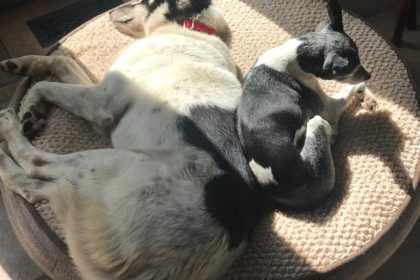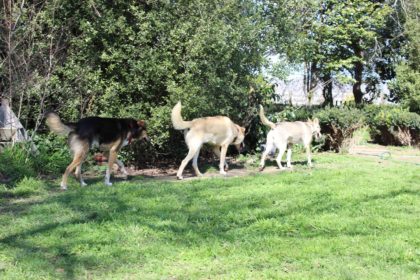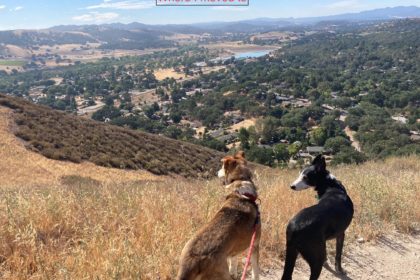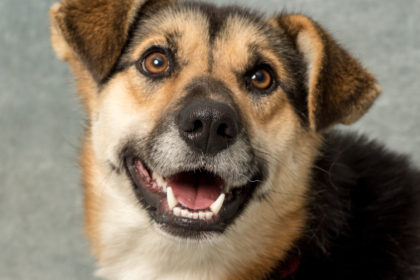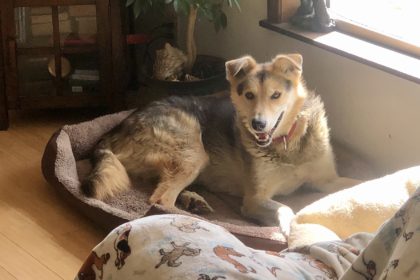1. Improving Endurance
By the first of January, the SP Kennel dogs have been in serious training for over 4 months. We have slowly built up their ability to run mile after mile without tiring. We are careful not to push them to the point of complete fatigue. Dogs’ muscles, like ours, get tired and consequently prone to soreness and cramping. The more consistent our training program, the better our dogs feel and the more miles they can travel at competitive speeds.
Our dogs continue to increase their endurance throughout the preliminary race season. In training, they will have successfully completed runs as long as any leg of the Copper Basin 300 Sled Dog Race. During the Copper Basin, in mid January, familiar length runs are bunched into consecutive days. The result is a “bump up” of endurance to 300 miles in 3 days. Throughout January and February, longer training runs and mid distance races (100 to 300 miles) continue to improve each dog’s endurance. The successful completion of 1,000 miles in less than 10 days is the ultimate goal for March first.
2. Building Strength
Our dogs provide the power that moves our sleds down the trail. The sleds are not heavy, only about 100 pounds at the start of the Copper Basin. But this weight still requires a dog to be strong and muscled. Most racing trails in Alaska manage to find hills and mountains to climb. When our dogs start a steep climb, they focus their energy and pull into the hill.
To develop the strength needed for these climbs, we train frequently in the mountains and hills. These training runs are longer and slower and they build the muscle mass needed during competition. There are two alternatives for strength and/or speed training near us in Two Rivers. We can cross the hills to the north for strength, or the river flats to the south for speed. We constantly assess the dogs’ strength and speed training needs and adjust our schedule accordingly.
3. Sustaining Speed
A competitive long distance racing team must be able to travel at a pace of 10 to 12 miles per hour. Our dogs have the innate physical ability to comfortably travel at this pace but we need to conscientiously train for speed to make it second nature. Rough trail conditions, deep snow or a heavy load all reduce the speed at which our teams can travel. We assess these conditions before every training run and determine the composition of each team and the ballast for each sled. On a cold day, with hard packed trails, we might pack 120 pounds of ballast. On a warm day, with 6 inches of fresh snow, the sled might carry only 40 pounds.
A dog team’s speed fluctuates. The dogs generally run slower in the mountains and faster on the flats. Mushers compensate for this fluctuation by physically assisting the team. We use a kicking technique, somewhat like propelling a scooter or skateboard, and we use a poling technique, pushing the sled forward with a single ski pole. These skills must be acquired and practiced. Allen and I have developed personal weight training programs to build specific ‘kicking’ and ‘poling’ muscles.
4. Supporting a Positive Mental Attitude
A dog’s mental attitude evolves with its training. When sled dogs are physically conditioned over time – never asking too much, never asking too little – they remain positive and exuberant about their jobs. The dogs believe that they can accomplish any task asked of them. This approach instills a strong trust and strengthens the ideal sled dog /musher relationship.

‘They believe that they can accomplish any task asked of them.’
With their bodies in prime condition, our dogs are empowered with extra energy. Lots of extra energy! They feel fantastic. They are happy. On their days off, these canine athletes engage in raucous play with their siblings and neighbors, run circles around their houses and talk to each other and to us as we complete dog yard chores. Their bodies are telling them that they are ready to run. It’s now critical that we factor this extra energy into the training program to maintain physical and mental balance. At this time of year the dogs rarely go more than 2 consecutive days without a training run or a race.
SP Kennel dog training protocols do change due to weather patterns, the conditions of individual dogs, dog and/or human injuries and many other variables. But every year dog conditioning is based on these four critical training goals: improving endurance, building strength, sustaining speed and supporting a positive mental attitude.
We are very pleased with 2007/2008 training so far. We are filling a fuel tank full of passion, fervor and enthusiasm. This tank will hold the reserves that energize the team during the 1,049 mile Iditarod Trail Sled Dog Race.



